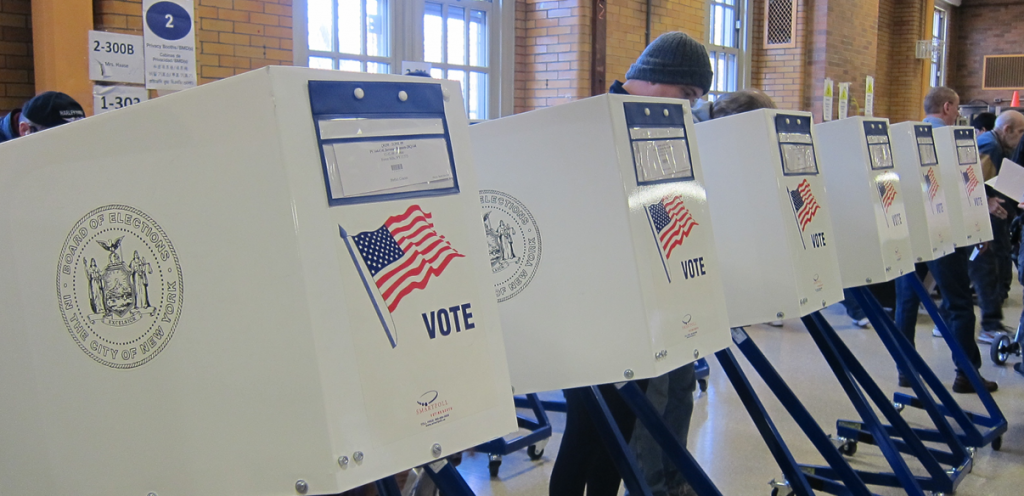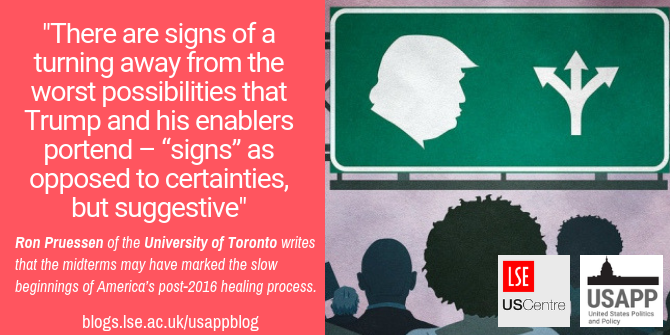
The 2018 off-year elections revealed more complex patterns than much instant analysis seemed to appreciate.

By Dr. Ronald W. Pruessen
Professor, Department of History
Munk School of Global Affairs and Public Policy
University of Toronto
David Axelrod has written that election campaigns are “MRIs of the soul” – and his experience as a key architect of Barack Obama’s political strategies has likely given him a surgeon’s knack for reading the results of the US’s 2018 scan. Me, I’m a historian, not a radiologist, and I’ll need more time to decipher the blurs and shadings of the image.
I’m not totally floundering with a diagnosis, however. I know with certainty that we need to appreciate the great complexity of 2018’s electoral dynamics – which I wrote about in my last post. Beyond that, though, I’m torn about just how to interpret the knots and tangles. I’m unable, in particular, to decide whether despair or hope is the more appropriate response to these off-year elections.
On one hand, November’s MRI of the American “soul” can prompt a chilling prognosis. Yes, there were enough Democratic successes to suggest some weakening of the Trump infection – but nothing like the cleansing purge that would have been more reassuring after almost two years of this presidency. No categorical, historic rout of Republican enablers (certainly not in the Senate or in Florida, Texas, and elsewhere); no sweeping eviction for those who have tolerated and/or led with lies, distortion, election rule finagling, and dog-whistle incitement to fevered hatred and even violence. (No need to even mention “collusion” with Russians to influence US elections or on behalf of high roller real estate deals – given an already long list of shameful behaviors.)
What does it say about the United States that Republicans have not been banished to frigid lands beyond the Wall (as in George R. R. Martin’s landscape, not the still equally fictional Rio Grande counterpart)? Is the country as it has been known – many attributes, many warts, and all – slipping into a dark future where racism, misogyny, greed, and lawlessness will metastasize in yet more fearsome ways?
There have, of course, been other times when the United States seemed to be heading toward disintegration or decay: there were severe strains under the Articles of Confederation in the 1780s, the wrenching sectional conflicts of the 1850s and the blood-letting of the Civil War, the mass suffering of the Great Depression, the internal battles over civil rights and the Vietnam War. The country survived these dark days, to be sure – and may even have been strengthened by them, given the drafting of the Constitution, the end of slavery, the evolution of social welfare systems, and civil rights progress.
But sometimes terrible struggles are lost or do permanent damage – as with Vietnam and the ongoing poison of racism. Is it impossible to imagine that current illnesses will grow more devastating rather than less? The national passion for football could be tellingly symbolic here – if the country’s fate comes to match the toll taken on players whose repeated concussions led to the irreversible damage of CTE (chronic traumatic encephalopathy). A possible variation on this scenario: in a global arena increasingly less amenable to being managed or used by the United States, does an unfamiliar path toward ever-worsening problems lie ahead? F. Scott Fitzgerald described two iconic characters in The Great Gatsby by saying “They were careless people, Tom and Daisy, they smashed up things and creatures and then retreated back into their money or their vast carelessness, or whatever it was that kept them together, and let other people clean up the mess they had made.” A 21st century twist on this might see Americans having to live with, not escape, the wreckage created by their privilege and callousness.

On the other hand: There are signs of a turning away from the worst possibilities that Trump and his enablers portend – “signs” as opposed to certainties, but suggestive. There is the Democratic gain of 40 seats in the House; there are the important victories of women and minority candidates; there is the evidence that some who voted for Trump in key areas in 2016 are starting to shift.
Perhaps we are seeing a slow-motion variation on backwoods treatment of a snake bite: cut the flesh, let the blood flow carry away the poison, then wait for recovery and healing. Americans have experienced a thousand bites and cuts in the past two years (no need for an MRI to see them) – as there have been millions of others since the 17th century. Millions, yes, with not a hint of hyperbole given the experiences of slaves and their posterity, Native Americans, Asian-Americans, Latinos, Jews, LGBTQ+ citizens – and women, always women. Incalculable losses of blood, painfully long-lingering bruises, and permanent scars. Maybe positive results of the recent wounds will become more evident in 2019 and 2020 – as they have at least sometimes in the past. The carnage of Antietam and Gettysburg – and the end of slavery. The brutality of Selma and Martin Luther King, Jr.’s assassination – and the halting but not halted march of civil rights progress. The deaths of Harvey Milk and Mathew Shephard, the murders in Orlando – and the advancement of LGBTQ+ rights. The pains inflicted by patriarchy and misogyny (no national voting rights until 1920, no Roe v. Wade until 1973, no calling out of Harvey Weinstein and Les Moonves until 2017-18) – and the sea-change potential of #metoo and emerging women leaders. None of these pairings has ever entailed full compensation (not one of them) for the suffering that preceded more positive results – but there may be at least some comfort in thinking that there could be ultimate gains after the paying of such terrible prices.
In deciphering the MRI of the 2018 elections and the American soul, I want to lean into hope rather than despair – even if I’m not yet convinced. It would be good to feel the relevance and beauty of the words that the literary critic Cleanth Brooks once wrote about the internal, productive tensions of poems by Donne and Shakespeare: “The kite properly loaded, tension maintained along the kite string, rises steadily against the thrust of the wind.”
Originally published by the London School of Economics, 12.12.2018, under a Creative Commons Attribution-NonCommercial 3.0 United States license.
